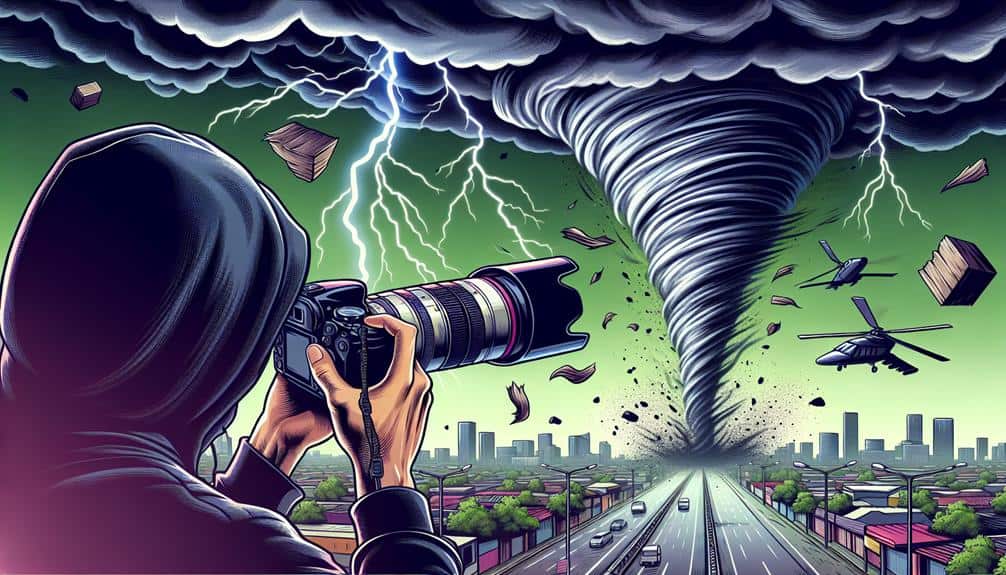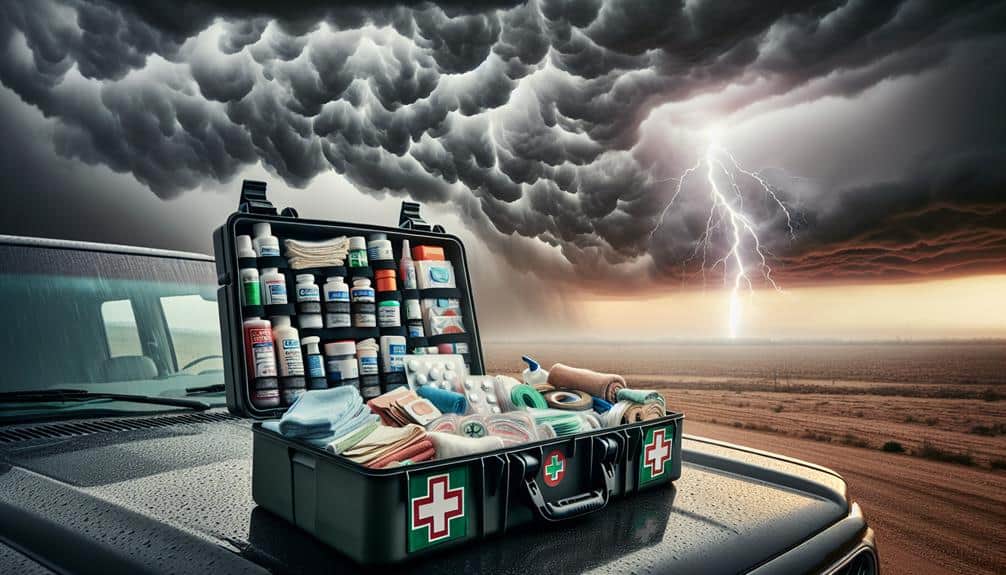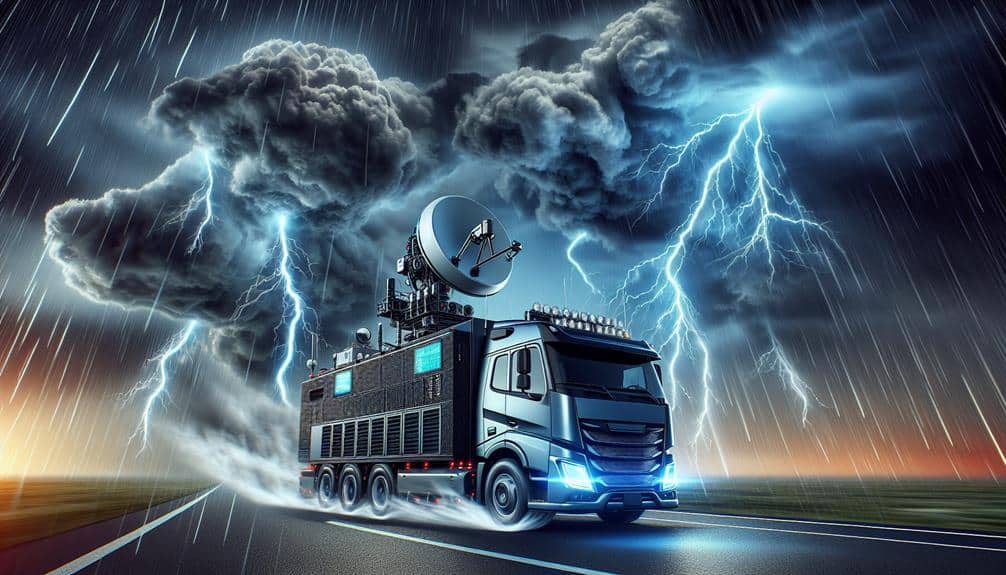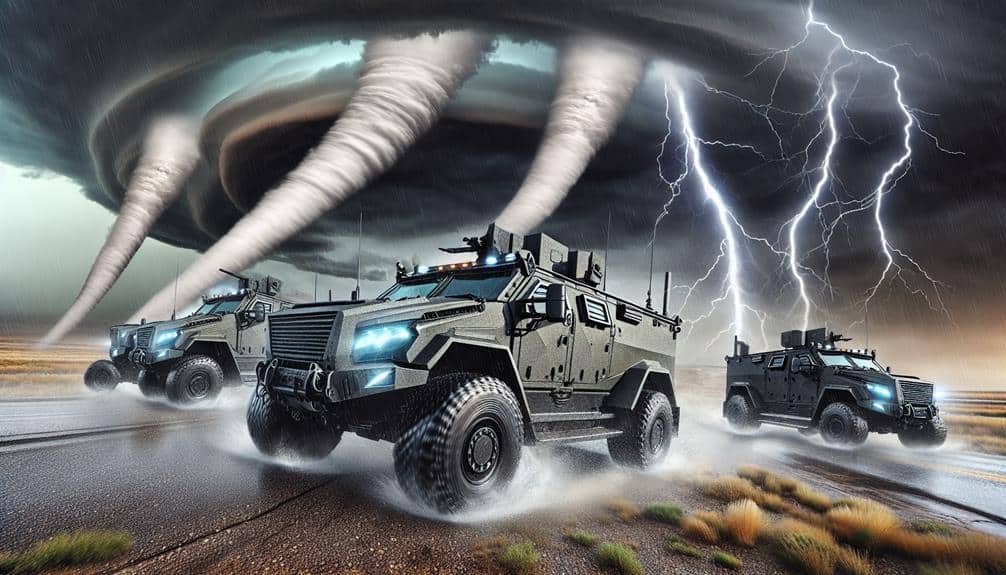We rely on essential storm chasing equipment to ensure our safety and enhance our data collection capabilities. Weather radios deliver real-time NOAA alerts, crucial for staying informed. GPS devices offer precise navigation, pivotal for positioning. Anemometers and barometers provide critical wind speed and atmospheric pressure data, aiding in accurate forecasts. High-resolution cameras and laptops enable detailed storm analysis and predictive modeling. First aid kits are indispensable for handling field emergencies. Each tool plays an essential role in our operations, and understanding their importance helps us navigate and study severe weather conditions more effectively. Discover how these tools integrate seamlessly into our storm chasing strategy.
Key Points
- Weather radios provide real-time NOAA alerts crucial for emergency communication and safety.
- GPS devices offer precise navigation and real-time positioning, essential for accurate storm tracking and data collection.
- Anemometers deliver real-time wind speed data, aiding in safety, forecasting, and storm analysis.
- Barometers measure atmospheric pressure changes, helping predict severe weather events and inform strategic positioning.
Weather Radios
Why do we prioritize weather radios as one of the most essential pieces of equipment for storm chasing?
The primary reason is their unparalleled reliability in emergency communication during severe weather events. Unlike cell networks, which can become congested or fail, weather radios provide continuous access to critical information. They directly receive NOAA alerts, ensuring we stay informed about storm updates in real-time.
Weather radios operate on dedicated frequencies that broadcast emergency alerts, weather conditions, and safety instructions. This is particularly crucial when we're in remote areas where other forms of communication may be unavailable. The ability to receive constant NOAA alerts allows us to track storm developments minute-by-minute, making our decisions more informed and timely.
Moreover, weather radios often come with features such as battery backup and automatic alert systems, ensuring they function even during power outages. This reliability is essential when we find ourselves in the midst of severe weather, as it helps us avoid hazardous situations and enhances our safety.
GPS Devices
GPS devices are essential for storm chasers, providing precise navigation and real-time positioning necessary for tracking and intercepting severe weather. By leveraging satellite data, we can achieve unparalleled navigation accuracy, which is vital when maneuvering through unpredictable storm paths. This precision enables us to position ourselves effectively, ensuring safety while capturing crucial data.
In the heat of chasing, time is of the essence. GPS devices streamline our ability to make split-second decisions by offering real-time updates on our exact location relative to the storm. This capability is important not only for collecting accurate meteorological data but also for ensuring we can swiftly adjust our course to avoid dangerous situations or maximize observational opportunities.
Moreover, GPS devices play a significant role in emergency response scenarios. Should we encounter sudden hazards or need to communicate our position to emergency services, the accurate and immediate location data provided by our GPS devices can be lifesaving. These devices allow us to relay our position with pinpoint precision, facilitating quicker rescue or assistance.
Anemometers
When storm chasing, we rely on anemometers to precisely measure wind speed, which is critical for understanding storm dynamics.
This data is essential for making real-time decisions and analyzing storm behavior.
Measuring Wind Speed
To accurately measure wind speed during a storm chase, we rely on anemometers, which provide real-time data critical for safety and analysis. By capturing precise wind speed measurements, we can better comprehend wind patterns, aiding our forecasting efforts. Accurate wind data allows us to predict storm behavior and movement, which is essential for making informed decisions on the ground. This predictive capability not only enhances our safety but also helps in planning our next moves effectively.
Anemometers are indispensable for tracking potential wind damage and implementing preventive measures. Knowing the exact wind speed helps us identify zones of extreme turbulence where the risk of structural damage is high. By recognizing these high-risk areas, we can avoid them or take necessary precautions to protect ourselves and our equipment. Additionally, this data can inform local authorities and communities, enabling them to prepare and respond more efficiently.
Our reliance on anemometers underscores their importance in storm chasing. Without this essential tool, our ability to interpret storm dynamics would be severely compromised. The real-time wind speed data they provide isn't just about understanding the storm—it's about maneuvering it safely and efficiently.
Essential Data Collection
Anemometers serve as the cornerstone of our data collection efforts, providing essential wind speed readings that drive our storm analysis and decision-making processes. These instruments are pivotal in our ability to perform accurate data analysis and storm tracking. By measuring wind velocities with precision, we can predict storm behavior and potential impact zones more reliably.
Our anemometers must be consistently calibrated and maintained to maintain the integrity of the data we collect. Equipment maintenance isn't just a routine task; it's a critical safety protocol. Regular checks and calibrations help us avoid data discrepancies that could lead to flawed predictions and potentially hazardous situations. Ensuring our anemometers are in excellent condition allows us to make informed decisions swiftly and confidently.
Safety protocols are also integral to our operations. Proper handling and placement of anemometers in the field guarantee both the accuracy of the data and the safety of our team. We follow strict guidelines to minimize risks while setting up and retrieving our equipment, especially in volatile weather conditions.
Barometers
Barometers are essential for storm chasers, providing accurate measurements of atmospheric pressure to predict weather changes effectively. By closely monitoring barometric pressure, we can identify significant shifts that often precede severe weather events. When pressure readings drop rapidly, it's a clear indicator that a storm system is intensifying. This data allows us to forecast storm development with a high degree of accuracy.
We rely on both traditional mercury barometers and modern digital variants. Mercury barometers offer a tried-and-true method of measuring atmospheric pressure, while digital barometers provide real-time data, which is vital during intense storm-chasing scenarios. The precision of these instruments enables us to make informed decisions about where to position ourselves to maximize safety and gather the best data.
Understanding barometric pressure is essential to storm prediction. The ability to anticipate changes in weather conditions gives us the freedom to plan our movements strategically, ensuring we're always one step ahead of storm systems.
High-Resolution Cameras

When storm chasing, high-resolution cameras are essential for capturing fine details that are important for analysis. These cameras document storm behavior in real time, providing us with data that can be reviewed later.
Capturing Fine Details
High-definition cameras are essential for storm chasers seeking to capture fine details that can provide crucial insights into storm structures and behaviors. The image quality these cameras offer is unmatched, enabling us to document even the most minute changes in a storm's development. This sharpness is vital for ensuring data accuracy, as every pixel can represent essential information about the storm's dynamics.
Moreover, detail capture isn't just about aesthetics; it's about storm tracking with precision. High-definition cameras allow us to monitor subtle shifts in cloud formations and lightning patterns, which are often precursors to significant weather events. By capturing these details, we can make more informed decisions on the ground, adjusting our positions to stay safe while gathering the most relevant data.
For storm chasers dedicated to advancing meteorological understanding, the ability to capture high-quality images is a game-changer. It transforms what might be seen as chaotic weather phenomena into analyzable data points. This level of detail is indispensable for refining predictive models and enhancing our overall comprehension of storm behaviors. With high-definition cameras, we're not just observing storms; we're dissecting them in real-time.
Documenting Storm Behavior
Documenting storm behavior necessitates the use of high-quality cameras that capture every intricate detail of a storm's movement and evolution. These cameras are essential for storm photography, allowing us to record observations with unparalleled clarity. By capturing high-definition images, we can scrutinize the minutiae of cloud formations, lightning strikes, and precipitation patterns. This precision is vital for identifying subtle changes in storm behavior, which often precede significant meteorological events.
High-resolution cameras enable us to observe storm patterns in real-time, providing data that's pivotal for immediate analysis. When we examine these detailed images, we can identify key indicators of storm development and dissipation. This level of detail aids in refining predictive models and enhances our understanding of storm dynamics.
Moreover, during data analysis, the high-resolution images serve as a reliable archival record. By comparing current observations with historical data, we can track long-term changes in storm patterns, contributing to broader climatological studies.
Essentially, high-resolution cameras aren't just tools for capturing stunning images; they're critical instruments for advancing our knowledge and forecasting capabilities. For those of us who chase storms, these cameras embody the freedom to explore, understand, and document the awe-inspiring power of nature.
Laptop Computers
A reliable laptop computer is essential for analyzing real-time weather data and adjusting our storm chasing strategy on the fly. With storm tracking and software analysis capabilities, we can process complex meteorological data instantly. This allows us to predict storm movements and make informed decisions on the ground. Real-time updates are vital; they give us the latest information on storm development and potential changes in direction, which is pivotal for both safety and effectiveness.
Our laptops are equipped with specialized meteorological research software that provides detailed models and simulations. These tools enable us to visualize storm structures and dynamics, enhancing our understanding of severe weather phenomena. By integrating data from various sources—such as radar, satellite imagery, and weather stations—we can create a detailed picture of the storm environment.
Moreover, the portability of a laptop ensures we're not tied to a single location. We can set up anywhere, whether in a vehicle or a temporary shelter, maintaining our operational flexibility. This freedom is crucial for adapting to rapidly changing conditions.
Essentially, our laptops are the nerve center of our storm chasing operations, providing the analytical power and real-time data we need to stay ahead of the storm.
First Aid Kits

Given the unpredictable nature of storm chasing, first aid kits are essential for addressing any injuries or medical emergencies that might arise in the field. Our commitment to safety and preparedness training can't be emphasized enough.
Storm chasing often places us in hazardous conditions where immediate emergency response mightn't be available. Hence, having a well-stocked first aid kit ensures we're equipped to handle a variety of medical needs.
A complete first aid kit should include essential medical supplies like bandages, antiseptics, pain relievers, and emergency blankets. We must also consider specialized items such as tourniquets and splints, which are vital for more serious injuries.
Each team member should be familiar with the contents of the kit and undergo regular preparedness training to guarantee effective emergency response.
Moreover, taking safety precautions like wearing protective gear and maintaining situational awareness can minimize the risk of injury, but accidents can still happen. Our first aid kits serve as a crucial line of defense, providing immediate care and stabilizing injuries until professional medical help is accessible.
In this high-stakes pursuit, being prepared isn't just a choice—it's a necessity.
Frequently Asked Questions
How Can I Safely Track a Storm's Path?
We can safely track a storm's path by using advanced storm tracking technology. It's essential for our emergency preparedness, ensuring we stay ahead of nature's fury. This tech gives us the freedom to act swiftly and decisively.
What Clothing Is Best for Storm Chasing?
For storm chasing, we need protective gear like waterproof jackets and sturdy boots. Layering options are essential for temperature changes. This combination guarantees safety and adaptability, allowing us to experience the storm's intensity without compromising our freedom.
How Do I Identify Safe Zones During a Storm?
Like experienced sailors steering through turbulent seas, we must identify safe zones by analyzing storm patterns and locating emergency shelters. We use radar data, topographical maps, and real-time updates to make sure we stay ahead of the storm's fury.
What Are the Legal Restrictions on Storm Chasing?
We must understand legal restrictions on storm chasing, specifically drone usage and privacy concerns. Regulations vary by region, but generally, we can't fly drones near people or property without permission, ensuring safety and respecting privacy rights.
How Do I Communicate With Other Storm Chasers?
To communicate with other storm chasers, we use group communication apps and radios for safety. Advanced technology like GPS and real-time data help coordination. This guarantees efficient information sharing and maximizes our freedom to chase safely.

